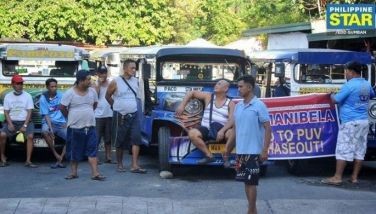Project NOAH or Noah’s ark

In the face of real climate change, Filipino leaders, from the national down to local executives, now have to make a choice: go with Project NOAH and its menu of programs for disaster mitigation and avoidance or live and let live on different versions of Noah’s ark.
While doing some research on typhoons that have struck the Philippines, I listed all the major or destructive typhoons that hit the country. For those of you who were around on Nov. 14, 1970 to be exact, I’m certain that you will never forget the rainmaker called Typhoon Yoling that ripped through the Greater Manila area. We were all unprepared for the never before experienced “super typhoon” which dumped so much rain that many kilometers of the only existing “National Highway” went underwater and only amphibious vehicles and US Army 6x6 surplus trucks were usable going north.
Since then the Philippines has been victimized by numerous typhoons and, beginning from 2009, things have gone progressively worse as typhoons went from average to super storms. In 2009, Typhoon Ondoy sunk the eastern part of Metro Manila where flood waters reached up to the second floor of many homes, washed away hundreds of cars and destroyed business establishments. In 2011 Typhoon Sendong arrived just before the Christmas holidays hitting Cagayan de Oro, Iligan, etc. It was mud everywhere, pitch black at night and for weeks people were still trying to find loved ones after the great mudslide. In December 2012 Typhoon Pablo struck with super typhoon strength, with most of the damage caused by strong winds. On Nov. 8, 2013 the unforgettable mother of typhoons Yolanda hit the Visayas and killed thousands upon thousands of Filipinos by way of a storm surge that many now call a tsunami.
On July 14, 2014 Typhoon Glenda registered as only one of the three super typhoons on record in the South China Sea and hit the eastern seaboard of the Philippines and crossed over all the way through the Calabarzon region and Palawan. Then came Lando in 2015, followed by Ramil in 2017, Ompong in 2018, Rolly in 2020 which was so destructive they retired the name from the roster of typhoons. Last year, 2021, at the height of COVID we experienced Typhoon Odette, and just last weekend we all got soaked, flooded and muddied or buried by Typhoon Paeng! The typhoons I listed here are only those that left high death tolls or physical destruction.
Typhoons are a part of life in the tropics but unlike 40 years ago, today’s typhoons feel like they come out of the Marvel Galaxy. Oftentimes their impact is incomprehensible. But the thing is, if we only learned to prioritize science and technology over political fiction and conflict, we could spare ourselves so much misery.
Yesterday, I got to interview Dr. Mahar Lagmay, executive director of Project Noah and the UP Resilience Institute to find out if they have anything that could help President Bongbong Marcos in addressing the challenge brought about by apparent climate change and the super disasters that come with them. Yes, they do, and it has long been available, except politics sidelined the project’s value and usefulness.
As the story goes, after the massive destruction caused by Typhoon Sendong in 2011, president Noynoy Aquino called for the government and scientists to come up with a disaster prevention and mitigation system in the Philippines. Various departments and agencies and members of the Philippine scientific community got together and formed a program that not only studied weather disturbances but also studied locations, geography, geology, population, environment, etc. By combining different inputs, the program could simulate different scenarios and impacts. By 2012, the program was launched and put through its initial phases and presumably would undergo further improvements over time and as more events and data are recorded.
Aside from having weather related functions, the program was capable of evaluating certain locations, its stability in the face of increasing human traffic, development and environmental impact, threats or hazards. More importantly, the program can evaluate scenarios based on different threat levels or data below or greater than observed or recorded historical information. This way, decision makers don’t rely merely on the past, because climate change has made much of it obsolete if not irrelevant.
I recall that just before COVID came about, one of the biggest concerns was the geological instability of mountainous areas in the Cordilleras. It gained national attention when miners seeking shelter were buried alive after heavy rains and from then on, public attention was drawn to how unstable the highland areas up north were due to mining, vegetable farming and residential growth. Even the governor of a province below the Cordillera area complained that the flooding in their province was not locally generated but due to the loss of forest cover, farming and logging in provinces above them. Since then we have all heard about areas declared as Red Zones or highly unstable and subject to landslides.
After so many people were buried in the landslide or mudslide in Maguindanao, no less than President Bongbong Marcos wants answers about climate change, mudslides, etc., and rightly so because all the flooding and mudslides won’t be solved or managed in a few years but by using the Program Noah for starters, PBBM can at least separate science from fiction, politics from solutions.
According to Dr. Lagmay, an updated version could be developed in six months if all the ingredients are on the table, as well as funding. I hope PBBM also looks into the impact of new roads and highways that end up becoming unforeseen canals for flood waters due to poor planning and research as well as establishment of safer townships. The President can now be the unifying force that will call together the best and brightest minds in the Philippines to address disaster prevention and management.
- Latest
- Trending



























